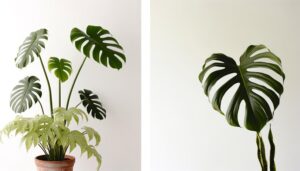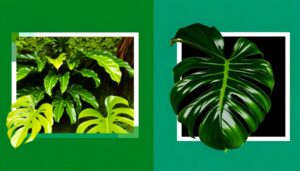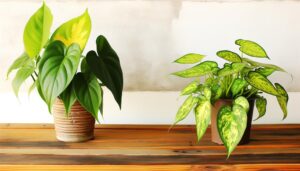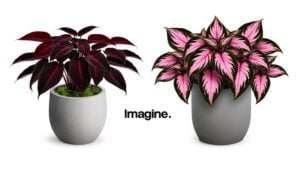Philodendron Deja Vu Vs Xanadu: Which One to Choose?
Philodendrons Deja Vu and Xanadu, native to Brazil’s rainforests, display distinct characteristics. Deja Vu’s deeply lobed, glossy leaves with serrated edges contrast with Xanadu’s broader, smoother, pinnate leaves.
Deja Vu is a climber via aerial roots, while Xanadu has a self-heading growth form. They both require high humidity and indirect light, but Deja Vu thrives with less frequent watering and slightly dry soil, whereas Xanadu prefers consistently moist conditions.
Optimum growth temperatures range between 65°F and 80°F. For detailed insights on how these differences influence care practices and environmental preferences, continue to explore.

Comparison of Philodendron Deja Vu and Philodendron Xanadu
| Feature | Philodendron Deja Vu | Philodendron Xanadu |
|---|---|---|
| Scientific Name | Philodendron sp. ‘Deja Vu’ | Philodendron bipinnatifidum ‘Xanadu’ |
| Leaf Texture | Smooth, glossy | Smooth, glossy |
| Leaf Shape | Deeply serrated, frilly edges | Deeply lobed, less frilly |
| Leaf Color | Dark green | Dark green |
| Growth Habit | Upright, compact | Upright, bushy |
| Mature Size | Medium-sized | Medium to large, can grow quite large |
| Light Preference | Bright, indirect light | Medium to bright filtered light |
| Watering Needs | Moderate, allow topsoil to dry between waterings | Moderate, occasional watering |
| Temperature Tolerance | Prefers warmer temperatures | Prefers warmer temperatures |
| Humidity Preference | Moderate to high | Moderate to high |
| Common Uses | Indoor houseplant, decorative | Indoor houseplant, decorative |
Origins and History
Originating from the diverse tropical regions of South America, particularly Brazil, both Philodendron Deja Vu and Philodendron Xanadu have distinct evolutionary pathways that have contributed to their unique morphological characteristics.
These species thrive in the understory of rainforests, where humidity levels are consistently high, and indirect sunlight prevails.
Philodendron Deja Vu, often found in moist, well-draining soils, exhibits a robust climbing habit, utilizing aerial roots to ascend tree trunks. Conversely, Philodendron Xanadu prefers slightly drier conditions and exhibits a self-heading growth form, characterized by its compact, bush-like structure.
Both species are adapted to environments with elevated humidity and stable temperatures, typically ranging between 18-24°C, which mimic their native habitats and are essential for best growth and development.
Leaf Shape and Texture
Philodendron Deja Vu and Philodendron Xanadu exhibit distinct differences in leaf morphology. The former displays deeply lobed, glossy leaves with a more serrated edge, while the latter showcases broader, pinnate leaves with a smoother texture.
The Deja Vu’s leaves are characterized by pronounced indentations and a lustrous surface, optimizing light reflection and enhancing photosynthesis. In contrast, Xanadu’s leaves are arranged in a more symmetrical, feather-like pattern with a matte finish, reducing water loss through transpiration.
Both species thrive in indirect sunlight and high humidity, but Deja Vu’s leaf architecture suggests an adaptive advantage in fluctuating light conditions, whereas Xanadu’s leaf design is indicative of a stable, humid microenvironment.
These morphological differences greatly influence their aesthetic and functional attributes.
Growth and Size
For growth and size, Philodendron Deja Vu typically reaches a height of 2 to 3 feet with a similar spread, while Philodendron Xanadu can grow up to 4 feet high and wide under ideal conditions.
Both species exhibit robust growth patterns, but their ultimate sizes are influenced by several factors:
- Nutrient Availability: Adequate fertilization and soil quality greatly influence their growth rates and overall size.
- Watering Regimen: Consistent moisture levels are crucial; both species prefer well-drained soil to avoid root rot.
- Temperature and Humidity: Best growth occurs in warm, humid environments, reflecting their tropical origins.
Understanding these parameters allows for more controlled cultivation, ensuring that each species achieves its potential dimensions under suitable horticultural practices.
Light Requirements
While both Philodendron Deja Vu and Xanadu thrive in bright, indirect light, their growth can be notably hindered by prolonged exposure to direct sunlight, which may cause leaf scorching and discoloration. This genus requires light that mimics their natural understory habitat, therefore, an east-facing window or filtered light through sheer curtains is ideal.
Insufficient light levels can lead to etiolation, manifested by elongated stems and sparse foliage. Conversely, artificial grow lights can be used to supplement natural light, ensuring a minimum of 10-12 hours of illumination daily. Monitoring leaf coloration and growth patterns is essential for adjusting light conditions.
Proper light management is vital for maintaining the lush, vibrant appearance characteristic of these popular ornamental plants.
Watering Needs
The watering needs of Philodendron Deja Vu and Philodendron Xanadu exhibit notable differences, primarily in frequency and soil moisture maintenance.
Philodendron Deja Vu generally requires less frequent watering and thrives in soil that is allowed to dry out slightly between waterings.
In contrast, Philodendron Xanadu benefits from consistently moist soil, necessitating more regular watering to prevent desiccation.
Frequency of Watering
Philodendron Deja Vu and Xanadu exhibit distinct watering requirements, necessitating careful observation of soil moisture levels to prevent overwatering or underwatering.
Philodendron Deja Vu thrives with moderate watering and benefits from allowing the top inch of soil to dry out between waterings. In contrast, Xanadu prefers consistently moist soil but is susceptible to root rot if left in waterlogged conditions.
To optimize growth:
- Philodendron Deja Vu: Water when the top 1-2 inches of soil are dry.
- Xanadu: Maintain even moisture without oversaturating the soil.
- Seasonal Adjustment: Reduce watering frequency in winter for both species, as their growth rate diminishes.
Proper watering is essential for their health, influencing nutrient uptake and overall vigor.
Soil Moisture Levels
Best soil moisture levels are crucial for the growth and health of both Philodendron Deja Vu and Xanadu, necessitating precise management to balance hydration and prevent root-related issues.
Philodendron Deja Vu thrives in consistently moist, well-draining soil, avoiding waterlogging to prevent root rot. Regular monitoring is important, ensuring the top inch of soil remains slightly dry between waterings.
Conversely, Philodendron Xanadu prefers moderately moist conditions, with soil that retains slight moisture but is not excessively saturated. Both species benefit from a substrate with good aeration and organic matter, which facilitates ideal water retention and drainage.
Utilizing a moisture meter can assist in maintaining favorable conditions, contributing to robust growth and minimizing the risk of fungal infections.
Soil Preferences
Best soil composition is crucial for the healthy growth of both Philodendron Deja Vu and Philodendron Xanadu, requiring a well-draining, nutrient-rich substrate. These tropical plants thrive in a medium that mimics their native, forest floor conditions.
Prime soil should exhibit the following characteristics:
- Aeration: Integrate perlite or orchid bark to boost oxygen flow to the roots, preventing root rot.
- Nutrient Content: Use a balanced mix of organic matter such as compost or peat moss to provide necessary macro and micronutrients.
- pH Balance: Sustain a slightly acidic to neutral pH level (5.5 to 7.0) to support nutrient availability and uptake.
Adhering to these soil preferences promotes robust growth and reduces vulnerability to disease.
Ideal Environments
Understanding the ideal environments for Philodendron Deja Vu and Xanadu is essential for optimizing their growth. Both species thrive under specific light conditions, with Deja Vu favoring bright, indirect light and Xanadu tolerating lower light levels.
Additionally, temperature preferences for these plants vary slightly, with Deja Vu flourishing in temperatures between 65-80°F and Xanadu preferring a range of 60-75°F.
Light Requirements
Philodendron Deja Vu and Xanadu thrive in environments with bright, indirect light, although they can tolerate lower light conditions, which makes them versatile options for indoor cultivation.
For ideal growth, these philodendrons require specific light conditions:
- Intensity: Bright, indirect light is ideal. Direct sunlight should be avoided as it can cause leaf scorching.
- Duration: Approximately 12-14 hours of light per day is beneficial. Utilization of artificial grow lights can supplement natural light during shorter daylight periods.
- Quality: Full-spectrum lighting that mimics natural sunlight is preferred. This type of light promotes robust photosynthesis and healthy foliage development.
These conditions ensure that the Philodendron Deja Vu and Xanadu maintain vibrant, lush foliage throughout their growth cycles.
Temperature Preferences
Consistently maintaining a temperature range between 65°F and 80°F (18°C to 27°C) is necessary for the best growth of Deja Vu and Xanadu philodendrons. These species thrive in stable, warm environments, as fluctuations can stress the plants, leading to subpar growth.
In cooler temperatures below 55°F (13°C), metabolic processes slow down, affecting leaf development and overall health. Conversely, temperatures exceeding 85°F (29°C) can induce heat stress, resulting in wilted foliage and decreased photosynthetic efficiency.
Ensuring proper ventilation while avoiding draughts is essential, as it helps maintain humidity levels and prevents temperature extremes. Both Deja Vu and Xanadu philodendrons demonstrate ideal physiological function within this controlled temperature spectrum, facilitating robust vegetative growth and ornamental appeal.
Conclusion
To sum up, Philodendron ‘Deja Vu’ and ‘Xanadu‘ display unique traits in leaf structure, growth patterns, and habitat preferences.
‘Deja Vu’ presents elongated, deeply divided leaves, whereas ‘Xanadu’ demonstrates wider, denser foliage.
They both flourish in indirect sunlight and regular watering, but their soil preferences and potential sizes vary.
These plant varieties are like two different sides of a coin, each specially suited to particular gardening conditions, yet connected by a shared ancestry and comparable care needs.






